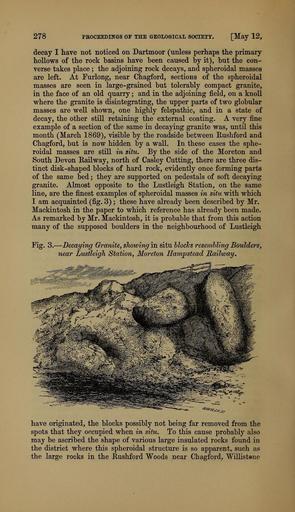MAKE A MEME
View Large Image

| View Original: | The_Quarterly_journal_of_the_Geological_Society_of_London_(12961316143).jpg (1185x2056) | |||
| Download: | Original | Medium | Small | Thumb |
| Courtesy of: | commons.wikimedia.org | More Like This | ||
| Keywords: The Quarterly journal of the Geological Society of London (12961316143).jpg 278 <br> PROCEEDINGS OF THE GEOLOGICAL SOCIETY May 12 <br> decay I have not noticed on Dartmoor unless perhaps the primary <br> hollows of the rock basins have been caused by it but the con- <br> verse takes place ; the adjoining rock decays and spheroidal masses <br> are left At Furlong near Chagford sections of the spheroidal <br> masses are seen in large-grained but tolerably compact granite <br> in the face of an old quarry ; and in the adjoining field on a knoll <br> where the granite is disintegrating the upper parts of two globular <br> masses are well shown one highly felspathic and in a state of <br> decay the other still retaining the external coating A very fine <br> example of a section of the same in decaying granite was until this <br> month March 1869 visible by the roadside between Rushford and <br> Chagford but is now hidden by a wall In these cases the sphe- <br> roidal masses are still in situ By the side of the Moreton and <br> South Devon Railway north of Casley Cutting there are three dis- <br> tinct disk-shaped blocks of hard rock evidently once forming parts <br> of the same bed ; they are supported on pedestals of soft decaying <br> granite Almost opposite to the Lustleigh Station on the same <br> line are the finest examples of spheroidal masses in situ with which <br> I am acquainted fig 3 ; these have already been described by Mr <br> Mackintosh in the paper to which reference has already been made <br> As remarked by Mr Mackintosh it is probable that from this action <br> many of the supposed boulders in the neighbourhood of Lustleigh <br> Fig 3 - <br> ” Decaying Granite showing in situ blocks resembling Boulders <br> near iMStleigh Station Moreton ffanvpstead Railway <br> – s c <br> have originated the blocks possibly not being far removed from the <br> spots that they occupied when in situ To this cause probably also <br> may be ascribed the shape of various large insulated rocks found in <br> the district where this spheroidal structure is so apparent such as <br> the large rocks in the Rushford Woods near Chagford Willist ne 36103125 111288 51125 Page 278 Text v 25 http //www biodiversitylibrary org/page/36103125 1869 Geological Society of London Biodiversity Heritage Library The Quarterly journal of the Geological Society of London v 25 1869 Geology Periodicals Smithsonian Libraries bhl page 36103125 dc identifier http //biodiversitylibrary org/page/36103125 smithsonian libraries Information field Flickr posted date ISOdate 2014-03-06 Check categories 2015 August 26 CC-BY-2 0 BioDivLibrary https //flickr com/photos/61021753 N02/12961316143 2015-08-26 15 55 12 cc-by-2 0 PD-old-70-1923 The Quarterly journal of the Geological Society of London 1869 Photos uploaded from Flickr by Fæ using a script | ||||